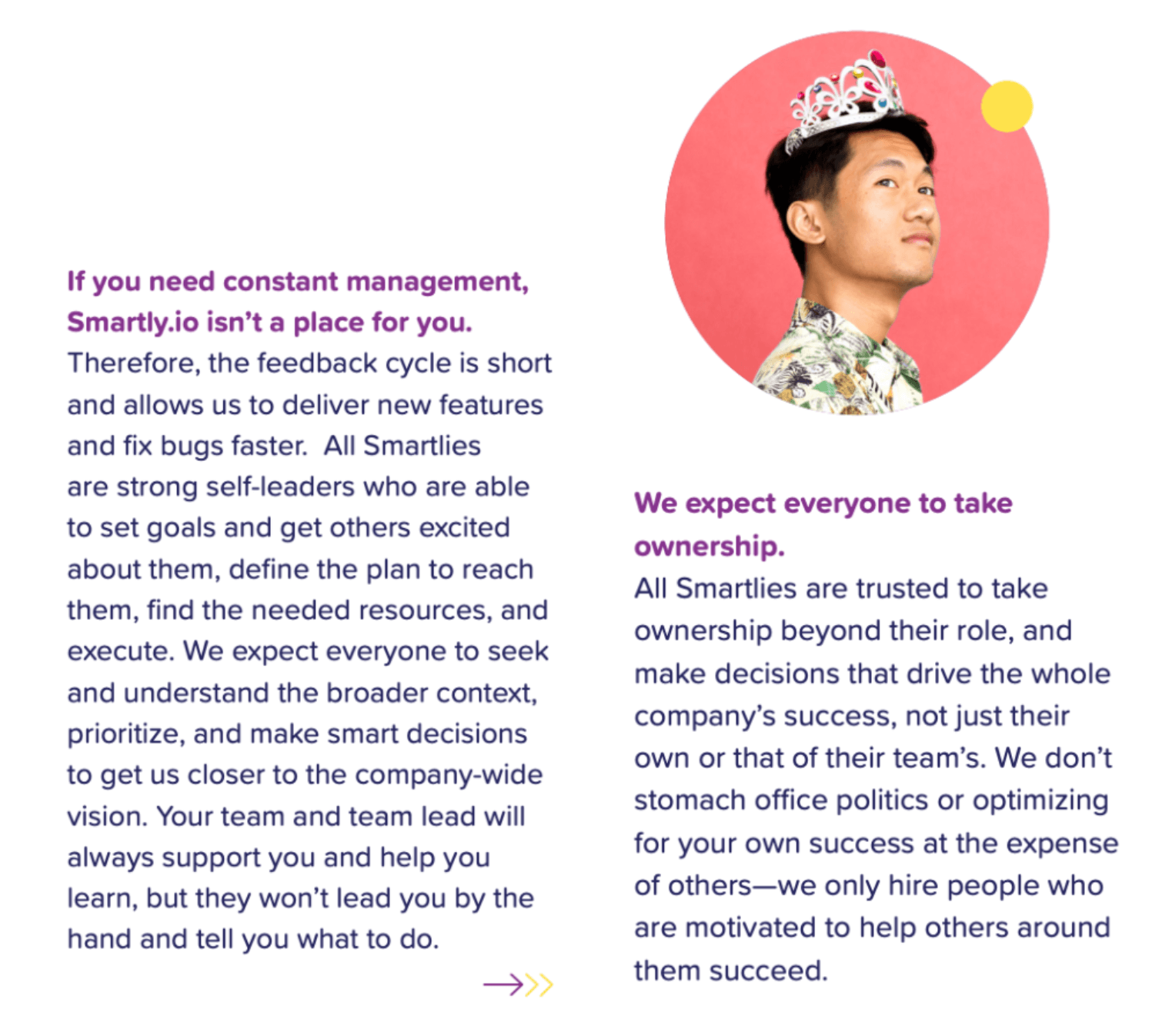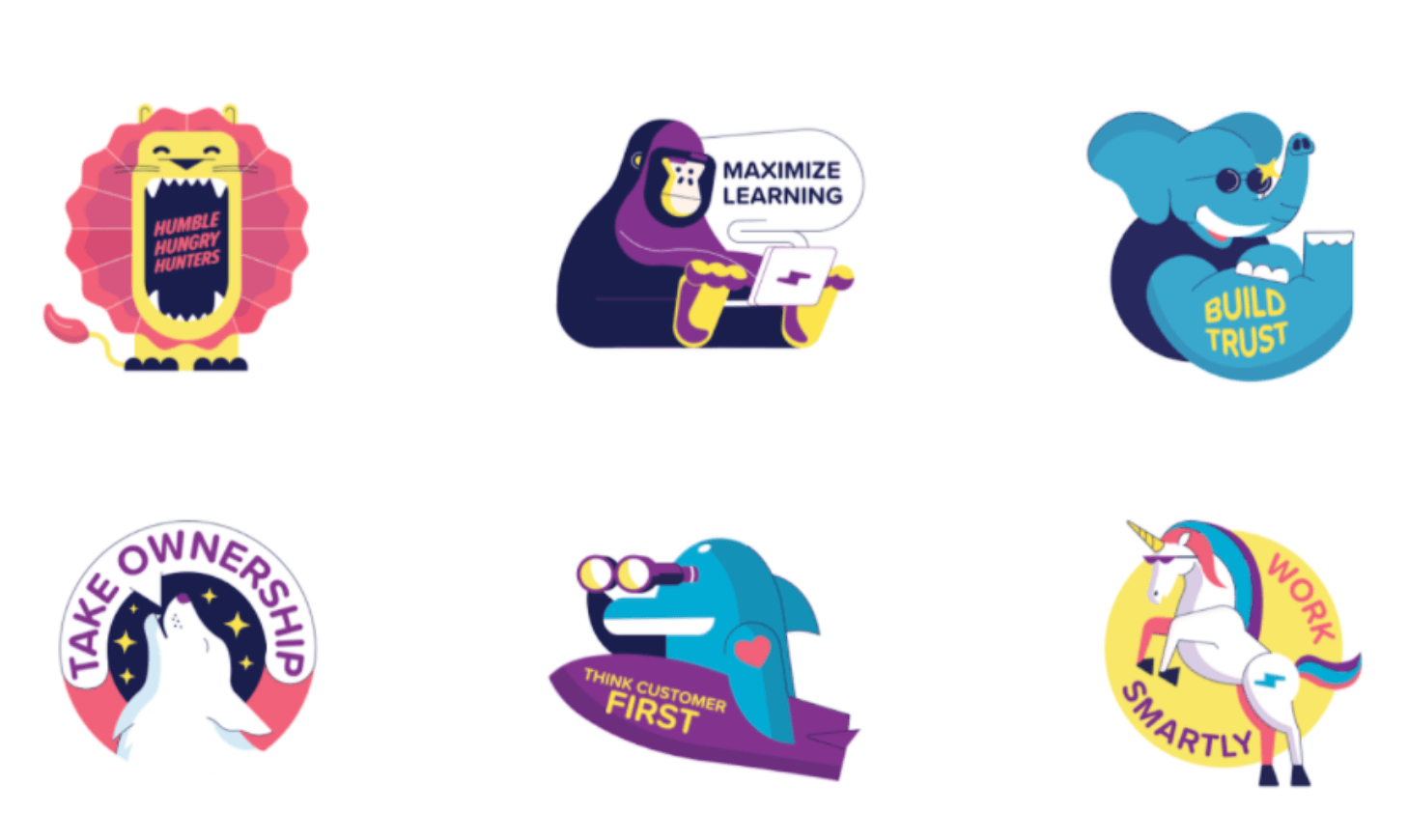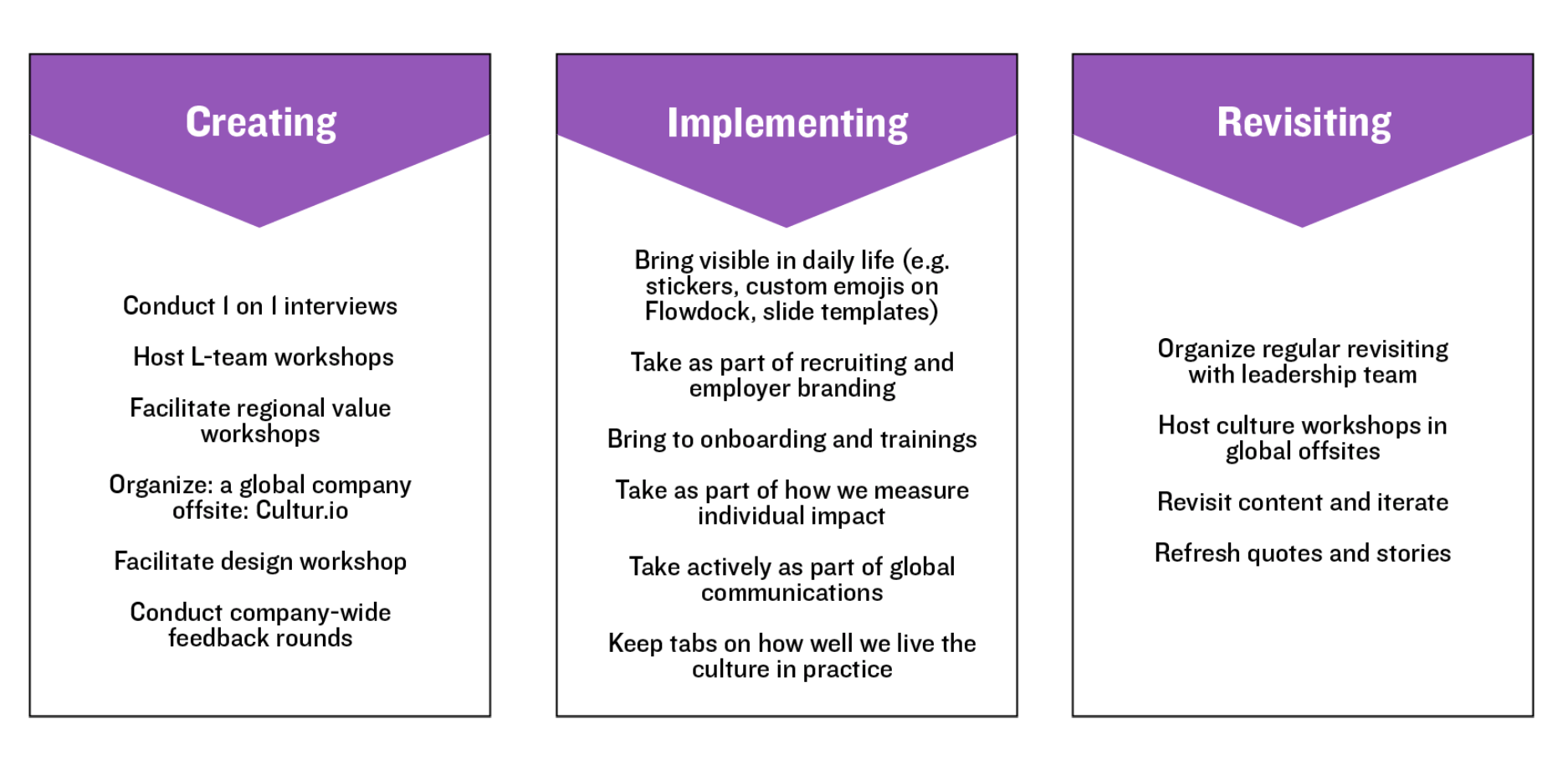Siiri Hakulinen & Julia Hämäläinen
A culture handbook can be a powerful strategic tool for leading a scaling organization. Smartly.io, an advertising technology company that helps advertisers automate every step of digital advertising to unlock greater performance and creativity, documented their culture when their team grew from two founders to 100 people across five offices worldwide in three years.
Expect to learn:
- What are culture handbooks and why they matter both internally and externally?
- How did Smartly.io benefit from a culture handbook while growing like crazy?
- How to start building one? What does it take to document culture?
- What tricks and tips did Smartly.io use in their handbook to make it memorable and fun?
- Why a culture handbook is never ready?
Another three years and 250 people later, it is obvious that the culture handbook has been invaluable in managing multiple growth spurts, attracting and engaging motivated employees, and above all, in bringing cohesion to an increasingly mosaic organization.
Siiri Hakulinen, who works as the Employer Brand & Employee Experience Lead at Smartly.io, and Julia Hämäläinen, former Global HR Operations Lead at Smartly.io and current COO at Inklusiiv, guide us through the hows and whys of documenting your culture.

A culture handbook helps control chaos as a company scales.
Company culture and values influence organizational behavior, decision-making and prioritization, and thus, ultimately, the bottom line. It serves a strategic purpose, and should be seen through such a lense. Much like the vision and mission, it is a framework that helps employees align their thinking and actions towards reaching shared goals. Writing and implementing a culture handbook is particularly useful for startups that are hiring at speed, all the while trying to steer their growing organization in a common direction.
The idea of a culture handbook came to us at Smartly.io when the company had doubled its size from 50 to 100 people in six months, and our team was increasingly distributed across continents. At that point, our culture was strong, but implicit. It got passed down from old to new employees by a sort of osmosis. We worried about how it would be adopted by the expanding and diversifying team. Things were bound to be lost in translation unless we made the culture and values explicit.
However, be critical when documenting your culture to hold on only values and those parts of the culture that defines your success as an organization. Otherwise, the culture handbook could reassert an exclusive culture only for a homogenous group of people. Diversity and inclusion should be taken into account from the start by building a welcoming environment that fosters safety and a sense of belonging. This starts by actively asking, listening, and involving everyone in your organization.
Double down on details and concrete examples to define your culture.
A tacit culture is sensitive to interpretation. We stumbled upon this at Smartly.io when we recognized that one of our founding values, humbleness, translated into discrepant behaviors in people from different cultural backgrounds. It wasn’t enough to say that we are humble, we needed to define what being humble meant in practice in the Smartly.io context.
To create a culture handbook that helps the organization behave in a confluent way, you need to optimize for clarity and practicality over everything else. Share concrete examples of how the company culture should manifest itself in interactions with colleagues and customers, as well as how it influences decision-making and prioritization. Show, don’t tell, what kind of behavior your company values, and you’ll make it easier for your people to act accordingly.
”Being a Humble Hungry Hunter is clearly depicted in how we do sales at Smartly.io. We're humble to ask the right questions and listen to customer feedback, but we also have the hunger to take on new challenges and bring value to our customers. Being grounded enough to understand customers' pain points is the key to closing deals.
Brett WagnerSenior Client Partner, Smartly.io San Francisco
An excerpt from our culture handbook, exemplifying how we used quotes by Smartlies to highlight what our values mean in practice and how they affect our ways of working.
Involving the entire organization takes time. It’s worth it.
It may be tempting to create the culture handbook amongst a few specific teams, like Executive Leadership, People Operations or Employer Branding. These teams usually have a relatively clear understanding of what the culture is like or at least what it should be, and soliciting the opinions of a larger group tends to make the process less straightforward. We insist, however, that the entire organization needs to have the opportunity to take part in documenting the culture.
Inviting the whole organization to chip in generates a shared sense of ownership, which in turn makes your employees more likely to embrace the result of the work. Interviewing founders and early team members, looking for stories on how the culture is demonstrated in daily work, hosting open feedback rounds and crowdsourcing content proved to be useful ways of getting the whole team’s input when creating our own handbook.
A public culture handbook is great for your employer brand.
While a culture handbook primarily serves an internal purpose, publishing it on your career page is a superb way of giving potential applicants a glimpse of your ways of working and helping them decide if they would like to join your team. We get constant feedback that our culture handbook has played a significant role in persuading new Smartlies to come work for us.
Going public with a culture handbook may tempt you to polish things up and exclude anything that might make potential job applicants turn the other way. Don’t shoot yourself in the leg, optimize for transparency instead. For example, our culture handbook states that people who need constant management don’t do well at Smartly.io. Entrepreneurially-minded applicants usually get excited about it, whereas people who prefer more clear-cut responsibility areas tend to pass us up, saving both their time and ours.

An honest culture handbook attracts the kind of people who will thrive in your culture and repels those who wouldn’t.
You might also hesitate to share details of your company culture out of fear for copycats. While we think our culture and values give us a competitive advantage, we don’t believe that they can be copied from one organization to another. Values and culture come alive in the context of everyday practices that are unique to the people in the organization.
Documenting your culture is only the first step. What comes next is a lot harder.
While documenting your company’s values and culture is a useful exercise in and of itself, it’s even more important to implement them into organizational practice. A culture handbook is only legitimate as long as it’s in line with reality. At Smartly.io, we have implemented our values and cultural principles into how we approach recruiting and onboarding, leadership, internal communication and feedback, as well as recognizing and rewarding employees.
If you want your people to act according to your values and culture, they need to be visible in the daily life of the organization. Two years back, no more than a handful of Smartlies remembered our six values. Only after the values were visualized and incorporated at the root of our internal communications, did people start to remember them by heart. Today, we even have customized value emojis that Smartlies have put to use in our internal chats.

Visualizing values makes them easier to memorize and more fun to use in internal communications.
Your culture (handbook) is never ready.
When we set out to write the culture handbook, we believed that culture is fairly static—something that stays more or less unchanged regardless of location or time. Over the course of the writing process we came to understand that culture, in fact, has a more dynamic nature. It evolves over time and with every new hire and varies between offices—and that’s completely natural.
Startup founders tend to dread changes in culture when their companies grow, establish offices abroad, or hire new leadership. However, culture needs to evolve in order to support the growing company. For example, “we’re full stack” used to be a basic tenet of the early Smartly.io culture, preferring generalists over specialists. Some years later we realized that we needed to introduce a certain degree of specialization in order to grow sustainably. We toned down on this attribute, emphasising trust and transparency instead, in order to keep our culture collaborative and steer clear of siloing.
As the culture is going to change anyway, it makes sense to guide that change in the right direction. Recruitment decisions are one of the most impactful ways to nurture your culture. When a company grows, it needs people with diverse backgrounds and different ways of thinking and solving problems to help take the company to the next level of success. So, rather than conserving the culture by looking for exact culture fits, companies should hire people who are committed to their values but elevate the culture in order to build more diverse, inclusive, and successful teams.
Since the culture evolves as the company grows, it’s crucial to keep on reviewing and refreshing the culture handbook regularly. At Smartly.io, we have been revisiting and reiterating our handbook on a yearly cadence. Building a culture handbook that stays strategically relevant over time requires commitment, but it’s worth the effort. At its best, a culture handbook can be a useful tool in guiding an organization through the different stages of growth.
Follow these tips for a successful culture handbook 👇🏽



